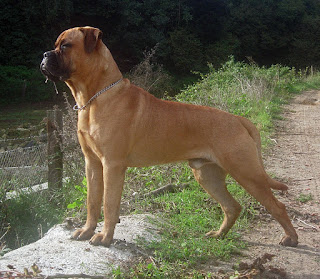The Bullmastiff is a large-sized
breed of domestic dog, with a solid build and a short muzzle. The Bullmastiff
shares the characteristics of molosser dogs, and was originally developed by
19th-century gamekeepers to guard estates. The breed's bloodlines are drawn
from the English Mastiff and the extinct Old English Bulldog. It was recognized
as a purebred dog by the English Kennel Club in 1924.
Appearance
Size
Males
should stand 25–27 inches (64–69 cm) tall (American Kennel Club (AKC) standard)
at the withers and weigh 110–130 pounds (50–59 kg). Females should be 24–26
inches (61–66 cm) at the withers, and 100–120 pounds (45–54 kg). Exceeding
these dimensions is discouraged by breeders.
Color
A
Bullmastiff's coat may appear in fawn, red, or brindle. These are the only
acceptable colors in the AKC standard. The fawn can range from a very light
brown to a reddish brown. Red can range from a light red-fawn to a dark, rich
red. Brindles are a striped overlay of the fawn or red. A Bullmastiff should
have no white markings, except for on the chest where a little white is
allowed.
Trainability
Bullmastiffs
are strong, powerful, but sensitive dogs. For a Bullmastiff to become a
well-behaved family member, consistency is needed. Training and socialization
is of high importance, as the breed can be independent. Dogs of this breed are
natural guardians of their home and owners. No special guard training is needed
for a Bullmastiff to react appropriately if its family is endangered. During
training, a Bullmastiff requires a special approach, because these dogs do not
like to repeat the same actions again and again. Activities Bullmastiffs enjoy
include obedience, agility, tracking, and carting.
Health
A UK
survey based on the lifespan of 96 Bullmastiffs found a median age of 7.5
years. A Bullmastiff does not stop growing until it is about three and a half
years of age.
Health
concerns within the breed include hip and elbow dysplasia, progressive retinal
atrophy, bloat, and cancer, with a relatively high incidence of lymphoma and
mast cell tumours.Bullmastiffs are prone to certain hereditary diseases,
including:
·
Hip dysplasia, affecting 24.5% of individuals
·
Elbow dysplasia, affecting 13.8% of individuals,
·
Entropion, hypothyroidism affecting 2.8% of
individuals,
·
Lymphoma
·
Progressive retinal atrophy is a particular
problem, since the trait is an autosomal dominant one. (This has recently been
called into question by another other medical team and has been proven that
some Bullmastiffs have autosomal recessive PRA genes. In America, this is being
investigated by the American Bullmastiff Health and Research Committee, and the
DNA Optigen test only works for dominant genes, so it is considered inadequate
at this time.)
·
Arthritis
·
Gastric dilatation volvulus, also known as
bloat.
Cosmetic
genetic problems include longhairs and "Dudleys". Both are recessives
and not common. The Dudley, named after a notable Bulldog breeder of the 19th
century, the Earl of Dudley, is a lack of pigment in the mask. It can be liver
colored or simply not present.
Famous Bullmastiffs
·
Rocky – Roloff family dog (Little People Big
World)
·
Swagger – the live mascot of the Cleveland
Browns
·
Butkus – actual pet of actor Sylvester Stallone
and featured in the movie Rocky






No comments:
Post a Comment